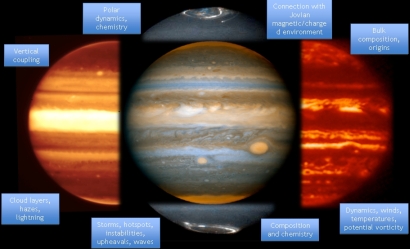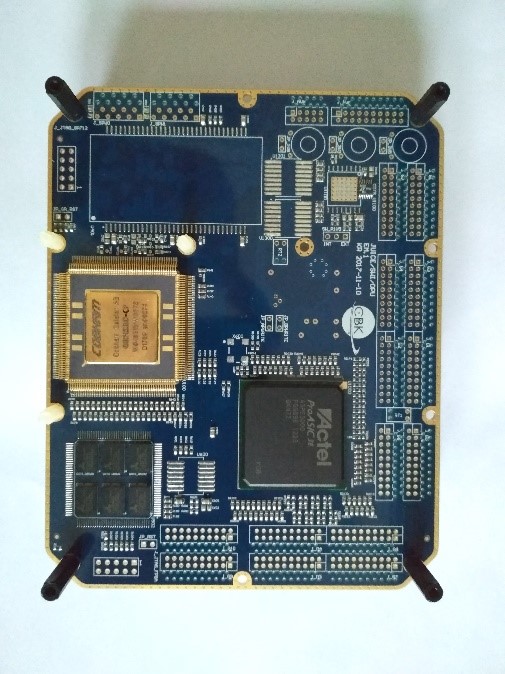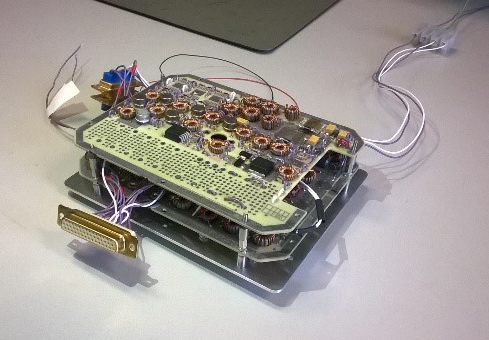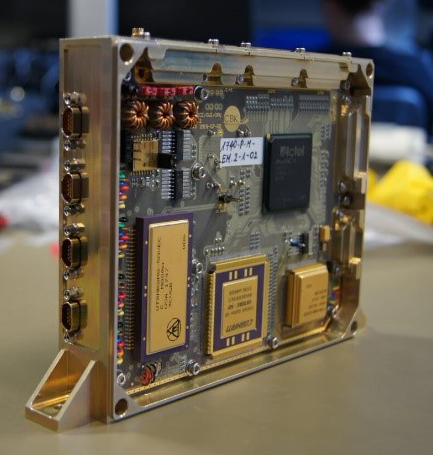![]() ESA JUICE mission lifted off on an Ariane 5 rocket from Europe’s Spaceport in French Guiana, at 14:14 CEST on 14 April 2023 to begin its eight-year journey to Jupiter.
ESA JUICE mission lifted off on an Ariane 5 rocket from Europe’s Spaceport in French Guiana, at 14:14 CEST on 14 April 2023 to begin its eight-year journey to Jupiter.

![]() Primary scientific objectives of this mission are the investigation of the middle atmosphere of Jupiter and the atmospheres and exospheres of the Galilean satellites. SWI will contribute to the understanding of the circulation regime in the atmosphere of Jupiter as a function of latitude and altitude, how the various atmospheric regions are dynamically coupled, and how the energy originating in Jupiter’s interior vertically propagates to the upper layers to be radiated in space. In this sense SWI complements the Juno mission. Furthermore SWI will determine important isotopic radios, monitor and trace known gases and search for new molecules. SWI will – for the first time – investigate the density, structure and distribution of the water atmospheres of Ganymede, Callisto and Europa from ground up to a few hundred km, determine its isotopic composition and general circulation. Io’s volcanic atmosphere will be studied through lines of SO2, SO, NaCl, and perhaps other species.. The secondary scientific objectives concerns the determination of thermophysical properties of the Galilean satellite surfaces by radiometric observations.
Primary scientific objectives of this mission are the investigation of the middle atmosphere of Jupiter and the atmospheres and exospheres of the Galilean satellites. SWI will contribute to the understanding of the circulation regime in the atmosphere of Jupiter as a function of latitude and altitude, how the various atmospheric regions are dynamically coupled, and how the energy originating in Jupiter’s interior vertically propagates to the upper layers to be radiated in space. In this sense SWI complements the Juno mission. Furthermore SWI will determine important isotopic radios, monitor and trace known gases and search for new molecules. SWI will – for the first time – investigate the density, structure and distribution of the water atmospheres of Ganymede, Callisto and Europa from ground up to a few hundred km, determine its isotopic composition and general circulation. Io’s volcanic atmosphere will be studied through lines of SO2, SO, NaCl, and perhaps other species.. The secondary scientific objectives concerns the determination of thermophysical properties of the Galilean satellite surfaces by radiometric observations.
![]() SWI (Sub-millimeter Wave Instrument) is one of the scientific instruments, which will be placed on the ESA's spacecraft JUICE (JUpiter ICy moons Experiment). It is a heterodyne spectrometer using a 30 cm antenna and working in two spectral ranges 1080-1275 GHz and 530-601 GHz with spectral resolving power of ~107.
SWI (Sub-millimeter Wave Instrument) is one of the scientific instruments, which will be placed on the ESA's spacecraft JUICE (JUpiter ICy moons Experiment). It is a heterodyne spectrometer using a 30 cm antenna and working in two spectral ranges 1080-1275 GHz and 530-601 GHz with spectral resolving power of ~107.
![]() SWI is built by a consortium led under the responsibility of the Principal Investigator Prof. Paul Hartogh from Max Planck Institute for Solar System Research in Gottingen, Germany.
SWI is built by a consortium led under the responsibility of the Principal Investigator Prof. Paul Hartogh from Max Planck Institute for Solar System Research in Gottingen, Germany.
![]() Polish team from CBK is involved in technical and scientific part of experiment. In technical part we are responsible for: the computer of instrument SWI (DPU) with its s/w , the power supply of the instrument, and tests. Moreover thermal and structural analysis of designed units. In frame of scientific goals, we will be involved in observation and analysis of atmosphere and their dynamics. The project is splitted on following phases realised by SWI consortium: phase A+B1 first stage, phase B2/C/D and phase E.
Polish team from CBK is involved in technical and scientific part of experiment. In technical part we are responsible for: the computer of instrument SWI (DPU) with its s/w , the power supply of the instrument, and tests. Moreover thermal and structural analysis of designed units. In frame of scientific goals, we will be involved in observation and analysis of atmosphere and their dynamics. The project is splitted on following phases realised by SWI consortium: phase A+B1 first stage, phase B2/C/D and phase E.
![]() In 2015 the project was in phase A/B1. In frame of this first stage the Development Model and Bread Boards of selected subunits have been developed. When the tests of these models are performed, then the PDR is planned. Next the development of STM and EQM (phase C) is planned. Flight model and selected modules of SF will be produced during phase D. The Polish side will also participate in assembling, test and calibrations units and the instrument.
In 2015 the project was in phase A/B1. In frame of this first stage the Development Model and Bread Boards of selected subunits have been developed. When the tests of these models are performed, then the PDR is planned. Next the development of STM and EQM (phase C) is planned. Flight model and selected modules of SF will be produced during phase D. The Polish side will also participate in assembling, test and calibrations units and the instrument.
![]() In 2016 the design and analysis of the Development Model of DPU and PSU were done. The DM DPU was delivered to MPS Gottingen. BIAS and DC/DC boards of PSU were manufactured, assembled and tested. These PCBs were delivered to MPS. All phases of the project were reported. Members of CBK team participated in meeting organized by MPS Gottingen and by CBK.
In 2016 the design and analysis of the Development Model of DPU and PSU were done. The DM DPU was delivered to MPS Gottingen. BIAS and DC/DC boards of PSU were manufactured, assembled and tested. These PCBs were delivered to MPS. All phases of the project were reported. Members of CBK team participated in meeting organized by MPS Gottingen and by CBK.

![]() In 2017 the main work on DPU was related to perform a design and manufacturing of the DPU pre-EM model. The main work on PSU was related to design, manufacturing and testing of PSU DCDC and HKSW DM models, and later to collect updated power requirements for PSU EM and flight models. The DPU pre-EM was redesign to include so called JUICE common DPU approach extended by specific SWI needs. Therefor DPU schematics were fully updated, followed by new PCB layout preparation. The PCB was manufactured and sent for assembly. Currently the board is being prepared for testing. What is worth to mention, while PCB manufacturing and components assembly a work on test setup started. Part of the test setup will be Spacecraft Interface Simulator (SIS) that was delivered to CBK.
In 2017 the main work on DPU was related to perform a design and manufacturing of the DPU pre-EM model. The main work on PSU was related to design, manufacturing and testing of PSU DCDC and HKSW DM models, and later to collect updated power requirements for PSU EM and flight models. The DPU pre-EM was redesign to include so called JUICE common DPU approach extended by specific SWI needs. Therefor DPU schematics were fully updated, followed by new PCB layout preparation. The PCB was manufactured and sent for assembly. Currently the board is being prepared for testing. What is worth to mention, while PCB manufacturing and components assembly a work on test setup started. Part of the test setup will be Spacecraft Interface Simulator (SIS) that was delivered to CBK.
![]() The PSU DCDC and HKSW DMs were designed, manufactured and tested. Then in August the boards were delivered to MPS for further integration and measurements with other SWI subsystems. Meantime an updated specifications for PSU were collected and work on PSU pre-EM models was initiated. The activities related with SWI Radiator unit was conducted in Micromechanical and Photonics Laboratory in CBK. The SWI requires its individual Radiator Unit to cool down heterodyne mixers to the range of ~130K, in order to maintain the noise on the low level. Recent activities related with Radiator included mechanical design of the Radiator, including mechanical finite-element analysis and thermal analysis as well. All work related with Radiator done by CBK had to be accepted by MPS and ESA prior to begin the manufacturing and purchasing necessary elements for the STM.
The PSU DCDC and HKSW DMs were designed, manufactured and tested. Then in August the boards were delivered to MPS for further integration and measurements with other SWI subsystems. Meantime an updated specifications for PSU were collected and work on PSU pre-EM models was initiated. The activities related with SWI Radiator unit was conducted in Micromechanical and Photonics Laboratory in CBK. The SWI requires its individual Radiator Unit to cool down heterodyne mixers to the range of ~130K, in order to maintain the noise on the low level. Recent activities related with Radiator included mechanical design of the Radiator, including mechanical finite-element analysis and thermal analysis as well. All work related with Radiator done by CBK had to be accepted by MPS and ESA prior to begin the manufacturing and purchasing necessary elements for the STM.

![]() In 2018, Both the DPU and PSU pre-EMs were tested and delivered to the Principal Investigator. The DPU and PSU EM1 were later integrated with EM1 subsystems and successfully delivered to the ESA. In parallel, the DPU EM2 was manufactured.
In 2018, Both the DPU and PSU pre-EMs were tested and delivered to the Principal Investigator. The DPU and PSU EM1 were later integrated with EM1 subsystems and successfully delivered to the ESA. In parallel, the DPU EM2 was manufactured.

![]() In 2019, most of the time has been dedicated to manufacturing and testing the DPU EM2 and PSU EM2 models, and updating the design of FM models. The two EM2s have been manufactured, and successfully tested and delivered to the Principal Investigator for further integration with other SWI subsystems. A model of an auxiliary DPU (the so-called AX) has been manufactured. This model was used to functionally test the Boot SW and FPGA before the PROM and flight FPGA are programmed/burned.
In 2019, most of the time has been dedicated to manufacturing and testing the DPU EM2 and PSU EM2 models, and updating the design of FM models. The two EM2s have been manufactured, and successfully tested and delivered to the Principal Investigator for further integration with other SWI subsystems. A model of an auxiliary DPU (the so-called AX) has been manufactured. This model was used to functionally test the Boot SW and FPGA before the PROM and flight FPGA are programmed/burned.
![]() In 2020, activities were focused on the manufacturing and testing of flight models. Despite challenges related to the Covid-19 situation, both DPU and PSU flight models were manufactured. After a successful test campaign, the DPU flight model was delivered to the PI for further integration with the SWI's other subsystems.
In 2020, activities were focused on the manufacturing and testing of flight models. Despite challenges related to the Covid-19 situation, both DPU and PSU flight models were manufactured. After a successful test campaign, the DPU flight model was delivered to the PI for further integration with the SWI's other subsystems.
![]() The Submillimetre Wave Instrument is one of the biggest of the 11 instruments onboard JUICE. It is a passive, heterodyne microwave spectrometer that is sensitive to radiation in the frequency bands 530–625 and 1080–1275 GHz. Radiation is received through a quasi-optical off-axis telescope with a 30 cm aperture, providing a spatial resolution of 2 mrad (FWHM) at 600 GHz. The telescope is equipped with a two-axis mechanism to allow scanning around the nadir viewing direction
in a range of ±76° along the spacecraft’s orbital plane, and ±4.3° perpendicular to the plane. Two, independent double sideband receivers provide simultaneous observing capability for two frequencies within the 530–625 GHz range of the baseline frequency band. Each receiver is
connected to its own high-resolution chirp transform spectrometer, providing a total bandwidth of 1 GHz at 100 kHz resolution (10,000 equidistant channels).
The Submillimetre Wave Instrument is one of the biggest of the 11 instruments onboard JUICE. It is a passive, heterodyne microwave spectrometer that is sensitive to radiation in the frequency bands 530–625 and 1080–1275 GHz. Radiation is received through a quasi-optical off-axis telescope with a 30 cm aperture, providing a spatial resolution of 2 mrad (FWHM) at 600 GHz. The telescope is equipped with a two-axis mechanism to allow scanning around the nadir viewing direction
in a range of ±76° along the spacecraft’s orbital plane, and ±4.3° perpendicular to the plane. Two, independent double sideband receivers provide simultaneous observing capability for two frequencies within the 530–625 GHz range of the baseline frequency band. Each receiver is
connected to its own high-resolution chirp transform spectrometer, providing a total bandwidth of 1 GHz at 100 kHz resolution (10,000 equidistant channels).
![]() Since 14 April 2023, the SWI instrument together with the entire JUICE mission complex is flying towards Jupiter.
Since 14 April 2023, the SWI instrument together with the entire JUICE mission complex is flying towards Jupiter.